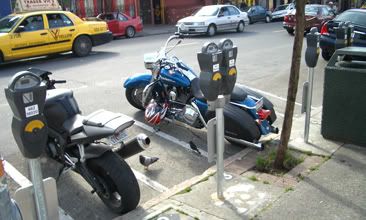
I tend to take lots of pictures when on vacation; oftentimes, many gigabytes worth of photos fill up my digital camera. My family and I most often travel to cities like Portland, Paris, Seattle, and San Francisco, where we all go on “urban hikes.” We grab coffee near our hotel and head off in one direction, walking until early afternoon, and then making a wide loop back. We typically walk through a rich variety of neighborhoods and commercial thoroughfares, occasionally crossing a civic center or college campus. Being in the architecture profession, you might think my pictures would be of buildings; instead, they tend to be a bit less interesting to the typical viewer. My vacation pictures often consist of details most people don’t notice: garage doors, bus shelters, commercial signage, and various forms of street parking. I use them to catalogue different approaches to city building, and they become precedents for sharing future ideas.

Metered parking spaces in San Francisco.
As its name suggests, “precedent imagery” is typically used to demonstrate an idea that has been successfully completed. An elected official promoting a proposal, a consultant explaining a planning concept or an architect describing a development can use these images to clarify what could be. These images can be presented in forms ranging from photos individually tacked to a wall for design meetings, to PowerPoint presentations for large audiences.
While precedent imagery can be incredibly helpful for developing a shared vision, such imagery can also be misleading as to what the ultimate product might be. While this could be done consciously, most often this occurs without malice, due to miscalculation or a misunderstanding of the depth of information behind the picture. Sometimes it is only the physical photograph that is misleading, as when a cited image conveys more information than what is necessary to explain a specific concept. In other cases, the image is simply more complicated than its use in a particular presentation indicates. This can occur because of a desire to describe an idea in a simple manner; a picture can play that role without revealing the intricacies that would be involved in actually implementing what the image contains in a new context.
There have been a number of occasions recently in Long Beach where precedent imagery has been utilized to convey ideas. From city planning efforts including the revisions to SEADIP on the eastside and the Downtown Visioning process, to development projects like the Press Telegram Lofts and the Seaport Marina on the east side of town, a range of presenters have used stimulating pictures of interesting architecture, happy people and lushly landscaped streets to describe their intentions for the future of Long Beach’s built environment. However, when in the audience, ask yourself: “What is this image saying?” “What will it take to implement that idea?” All the beautiful pictures in the world mean little when the resources and collective will are not available to complete that vision. If you like what you see in a particular image, latch onto it and make sure that the common idea shared by you and the presenter is implemented. One can almost treat it like a contract that the intention remains through to implementation.
In future columns I will use precedents to describe ideas. I encourage feedback from readers about the validity of such imagery. I also support readers contributing other precedents that might be relevant to the conversation. I find that an idea is richer when others can share in creating it.
In the interests of full disclosure, my office Studio One Eleven is currently the consultant for Downtown Visioning.
